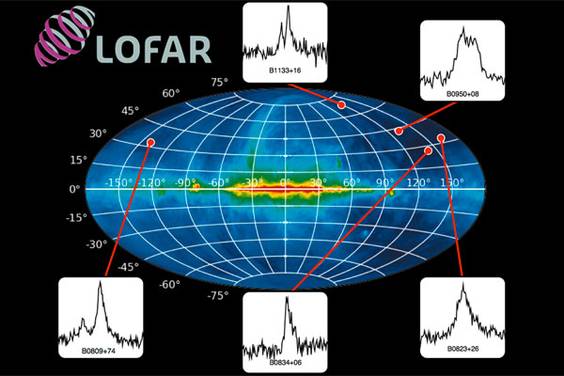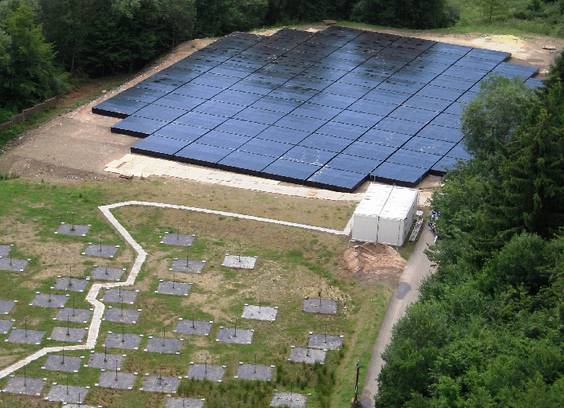15.04.2011
LOFAR Takes the Pulse of the Radio Sky
The European "LOw Frequency ARray" enables the most sensitive pulsar observations up to now at low frequency
An international team of astronomers under participation of German scientists has succeeded in recording the most sensitive radio observations of pulsars up to now at a low frequency with the European radio telescope network LOFAR. Pulsars are extremely fast- rotating neutron stars which develop during the explosion of extremely massive stars as supernovae. A considerable number of scientists are involved in this project, which is organized in the German consortium GLOW ("German LOng Wavelength"). This consortium also includes the Excellence Cluster “Universe”.
The research group of Prof. Michael Kramer of the Max Planck Institute for Radio Astronomy, Bonn is studying pulsars in particular. The pulsar observations represent the first results of the LOFAR observations to be published in a peer-reviewed journal; the publication will appear soon in the European scientific journal "Astronomy & Astrophysics".
The European low frequency radio telescope LOFAR is the first of a whole series of novel radio telescopes for the exploration of the Universe at the lowest frequencies accessible at all from the surface of the earth. The discovery of the new pulsars and their investigation at low frequencies represent a key project for science using LOFAR.
With LOFAR the astronomers have reverted to the frequency range of initial pulsar measurements. This time, however, modern computer technology and the linking up of individual telescopes via high-speed optical fiber connections have increased the performance of the telescopes many times over. It is thus possible with LOFAR to study the pulses of radio emission in detail in addition to the effects of gravitational physics and the properties of the interstellar medium in our Milky Way.
LOFAR functions with the help of thousands of tiny antennas which are spread throughout different European countries and are connected to one another with high-speed Internet lines. The evaluation takes place via a powerful super computer in the vicinity of the central LOFAR station at ASTRON in the Netherlands.
The LOFAR telescopes have no moving parts; in fact the alignment to relate telescope positions with the sky takes place via digital time delay building blocks. Considerably higher flexibility is thus possible in the data analysis. For example, completely different parts of the sky can be surveyed at the same time.
"The mapping processes with LOFAR clearly differ from those using classic radio telescopes", says Ralf-Jürgen Dettmar, professor at the Ruhr University Bochum and chairman of the German GLOW Consortium. "With the classic telescopes only relatively small areas of the sky can be surveyed in a short time, whereas LOFAR makes it possible to take snapshots of extensive regions of the sky in the same length of time. This permits the monitoring of these regions in order to discover new pulsars and possibly other unusual phenomena in the sky."
For the next steps in the investigation of pulsars with LOFAR the research team wants to make use of the special capabilities of this radio telescope in order to tackle the signaling mechanism of the pulsars. They also want to continue discovering pulsars which escaped notice during previous search programs. "LOFAR is a fantastic telescope in order to supplement our previous observation instruments for the investigation of pulsars at long wavelengths", explains Michael Kramer, director at the Max Planck Institute for Radio Astronomy in Bonn. "LOFAR has the potential to detect a large number of pulsars in the neighborhood of our sun that have remained undiscovered up to now. With their help we want to deliver evidence of gravitational waves."
Radio waves can be studied with LOFAR over a very extensive frequency range, greater than a range of 10 to 240 megahertz. In addition to the search for pulsars LOFAR will be implemented in the long-wave radio range for sky mapping. It will continue to be used in order to answer cosmological questions, monitor solar activity and investigate planets. Furthermore LOFAR also acts as a forerunner project for the "Square Kilometre Array" (SKA), the planned global radio telescope of the next generation.
LOFAR: The "International LOFAR Telescope" (ILT) was planned mainly by ASTRON, the Netherlands Institute for Radio Astronomy in cooperation with a number of international partners. There are currently four German LOFAR stations in operation; the LOFAR station in Effelsberg is run by MPIfR (Max Planck Institute for Radio Astronomy), the station in Unterweilenbach by MPAb (Max Planck Institute for Astrophysics), the station in Tautenburg by the Thüringer Landessternwarte and the station in Bornim by the Astrophysical Institute Potsdam. The German LOFAR partners have joined GLOW, the "German LOng Wavelength" Consortium. In its final form, the international LOFAR telescope will comprise at least 36 individual stations in the Netherlands and eight stations in Germany, France, Great Britain and Sweden. With five stations up to now, Germany represents the most important international partner. Each station is made up of hundreds of dipole antennas which form a huge telescope having an area of half of Europe when they are connected up to one another electronically.
GLOW is the German Long Wavelength Consortium (Deutsches Konsortium zur Messung langer Radiowellen). The chairman of the consortium is Prof. Ralf-Jürgen Dettmar (Ruhr University Bochum). His vice-chairman is Prof. Marcus Brüggen (Jacobs University Bremen). The members of the consortium are the astronomical institutes of the universities in Bielefeld, Bochum, Bonn and Cologne, the Max Planck Institute for Radio Astronomy in Bonn, the Jacobs University Bremen, the Max Planck Institute for Astrophysics in Garching, the Excellence Cluster "Universe", Garching, the Hamburger Sternwarte (Hamburg Observatory), the Forschungszentrum Jülich (Research Center Jülich), the Astrophysical Institute Potsdam and the Thüringer Landessternwarte Tautenburg (Thüringer State Observatory Tautenburg). Their common goals are the building and coordination of the German LOFAR network and the associated scientific network, as well as the sponsoring of student training.
Original publication:
Observing pulsars and fast transients with LOFAR (PDF, 15.7 MByte), B. W. Stappers et al., 2011, Astronomy & Astrophysics, DOI: 10.1051/0004-6361/201116681 (see also Observing pulsars and fast transients with LOFAR , arXiv:1104.1577 [astro-ph.SR]).
Parallel press releases:
LOFAR takes the pulse of the radio sky, ASTRON Press Release, April 14, 2011.
Further information:
International LOFAR Telescope (in English)
German LOFAR Stations (in English)
Deutsches LOFAR-Konsortium (German Long Wavelength Consortium, GLOW).
Max Planck Institute for Radio Astronomy (MPIfR).








